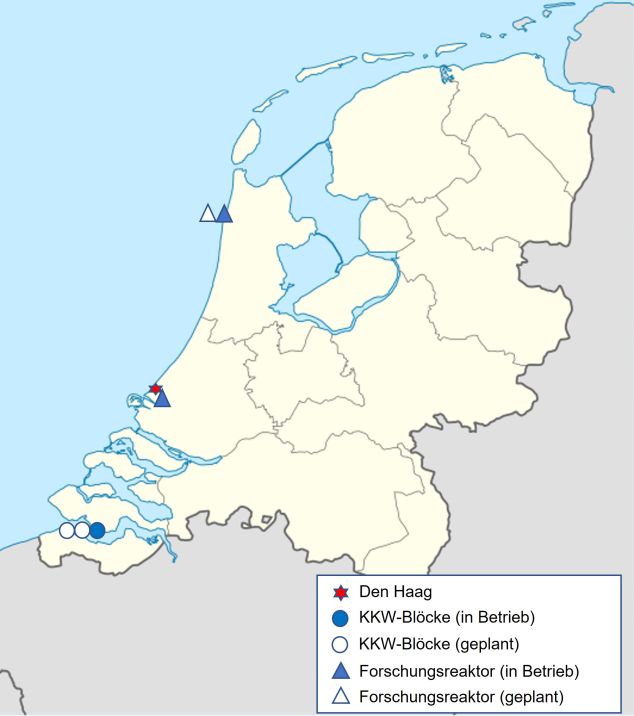Nuclear energy in the Netherlands (01.02.2023)
• A new research reactor, PALLAS, is planned to be built in Petten to replace the one still in operation there.
• Two Dutch companies intend to deploy SMR in the Netherlands together with foreign partners.
Status quo of electricity generation
The Netherlands operate one nuclear power plant (NPP). The pressurised water reactor, located in the province of Zeeland near the town of Borssele, was built by KWU and commissioned in 1973. After modernisation in 2006, the NPP now has an electrical output of 482 MW. This corresponds to a share of approx. 3 % of the current total electricity generation capacity in the Netherlands.

Political and legal framework conditions
With its climate legislation from 2019, the Netherlands has set itself the binding goal of halving emissions of climate-damaging greenhouse gases by 2030 and reducing them by 95% by 2050 (measured in each case against 1990 levels). To this end, it is intended to convert electricity generation to 100% renewable energies by 2050. In 2018, it was already decided to phase out coal-fired power generation by 2030.
This strategy was modified by the new coalition government elected in 2021 to include a role for nuclear energy in achieving the Dutch climate targets, both in terms of electricity generation in addition to RE and through the production of hydrogen.

Current plans and projects
Large NPPs. In particular, the Dutch government is seeking to extend the operating life of the Borssele NPP and to build two more power reactors. To this end, the cabinet has commissioned the Dutch regulatory and licensing authority ANVS to examine whether and under what conditions continued operation of the existing reactor beyond 2033 would be feasible from a (safety) technical point of view.
From the government's point of view, Generation III+ reactors with an electrical output of 1,000 to 1,600 MW can be considered for new build. It is planned to support planning and construction of two reactors by the state with about 500 million euros until 2025 and a total of about 5 billion euros until 2030. Commissioning of the new units is envisaged for 2035. On 9 December 2022, the government stated that, as things stand, the Borssele site was preferred for the new build. A site in the region around Rotterdam would be a possible alternative location. In view of the necessary investigations, the government assumes that a final decision on the site cannot be made before the end of 2024.
SMR. The Thorizon company, which was spun off from the Dutch Nuclear Research and Consultancy Group (NRG – see below), plans to build a thorium reactor as a pilot plant at the Borssele site by 2035. According to current plans, the reactor, which will use long-lived radioactive waste as fuel in addition to thorium, will have a thermal output of 250 MW. Thorizon cooperates with NRG, Orano and EPZ, the operator of the Borssele NPP.
In August 2022, the Dutch company ULC-Energy BV and the British Rolls Royce SMR concluded an agreement aimed at deploying the British SMR in the Netherlands with an electrical output of 470 MW.
Research reactors
Currently, NRG operates a research reactor in Petten on behalf of the European Commission’s Joint Research Centre (JRC). The 45 MW high-flux reactor was commissioned in 1961 and is used today in particular for the extraction of isotopes used in medicine (especially molybdenum-99). At the University of Delft, a research reactor in pool design with a thermal output of 2 MW has been in operation since 1963, which is also used, among other things, for medical purposes and for materials research.
It is planned to replace the reactor in Petten by a new research reactor (PALLAS). PALLAS is a pool reactor, which is to be operated with low-enriched uranium (< 20%). Initial site preparation work started in November 2022; after expiry of the appeal period against the construction permit, actual construction work began in May 2023.
Uranium enrichment
In Almelo, not far from the German border, Urenco operates one of its three European plants for the enrichment of uranium for civilian purposes. The gas ultracentrifuges used for enrichment are also manufactured at this site by ETC, a joint venture between Urenco and Orano.
Sources
National Climate Agreement of The Netherlands
Country Profil “Netherlands” of the World Nuclear Association
Data and Statistics „Netherlands“ der IEA
Power Reactor Safety System of the IAEA
Research Reactor Database of the IAEA